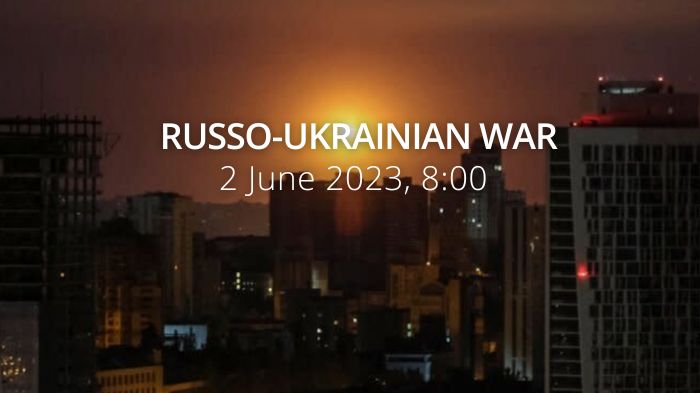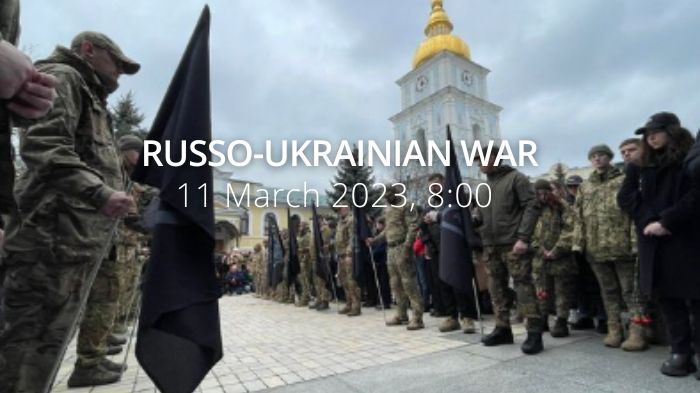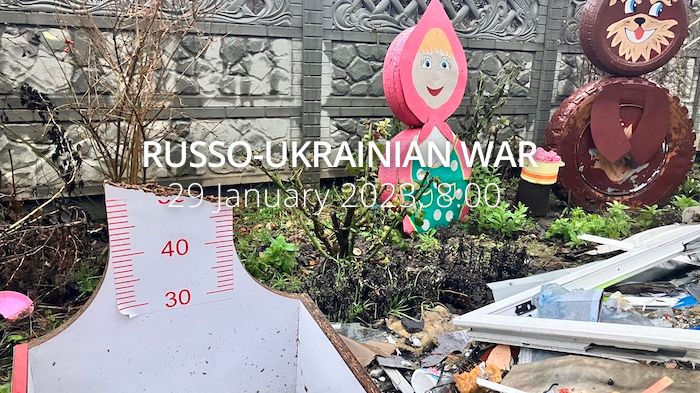Mass Murder of Ukrainian Prisoners of War in Olenivka. Russia moves military equipment towards Kherson and Crimea. Ukrainians blow up more Russian ammunition depots. Ukraine liberates three settlements in the Kherson Oblast over the past two weeks. Germany sends 16 armored bridge layers to the Ukrainian army. Ten ships loaded with grain are ready to leave ‘Odesa’ and ‘Chornomorsk’ ports. The cost of insurance for ships with Ukrainian grain will increase hundreds of times. Ukrainian farmers have their doubts about an international agreement to ease a blockade on grain shipments through the Black Sea.
A map of the approximate situation on the ground in Ukraine as of 00:00 UTC 30/07/22. pic.twitter.com/gc0tgsrE8K
— War Mapper (@War_Mapper) July 30, 2022
According to military expert Stanislav Haider, as of July 30,
North Macedonia has decided to supply T-72 tanks to Ukraine, and Germany is preparing to transfer 16 bridge-laying tanks to Ukraine.
Donetsk Oblast. Soledar remains under full control of the Ukrainian Armed Forces. The area of Verkhniokamianske, Ivano-Dariivka saw a Russian offensive repulsed, but reconnaissance groups were strengthened there. Direct attacks on the Ukrainian forces continued in the Bakhmut and Avdiivka areas, although the situation in the area of Bakhmut remains difficult. Ukrainian forces are holding back the Russians there along the lines of Semihiria-Kodema-Zaitseve and Bakhmutske-Yakovlivka. Fighting continues near Krasnohorivka. Russians carried out and failed an assault from two directions at Mykilske, Pavlivka, Yehorivka trying to recapture their lost positions. The Armed Forces of Ukraine are counterattacking in the Volnovakha area.
Kharkiv Oblast. Ukrainians eliminated another reconnaissance group of Russians, now in the Shchurivka area. The Russian forces unsuccessfully tried to storm Prudianka and Udy. Pressure on the Russian troops continues in the Izium direction's Brazhkivka area, where the Russians wanted to recapture their lost positions near Brazhivka and Dmytrivka but had to retreat.
Kherson Oblast. Ukrainian forces continue their offensive in four main directions, making small territorial gains. The Armed Forces of Ukraine continue to attack Novopetrivka and Snihurivka, Russian strongholds and positions are slowly being destroyed. The fight is hard because the invaders are well dug in, but soon their flanks will be exposed.
Ukraine also continues to strike key Russian ammunition depots and bridges, which significantly impairs their logistical capabilities. Ukrainian troops attacked the floating crossing ferry near the Antonivskyi bridge.
Although the Russians are now packing this direction with troops as much as possible (their 106th Airborne Division arrived here from Izium being the 3rd Russian paratrooper division transferred here so far), their current efforts are focused on maintaining the occupied positions, because the rear capabilities of the Russian army in Kherson Region have been severely impaired.
Zaporizhzhia Oblast. The Ukrainian army continues to pressure the occupiers in the areas of Nesterianka, Dorozhnianka, Shcherbaky, where the Ukrainian artillery works successfully. Russians continue to transfer troops here - an additional artillery division appeared in the Vasylivka area.
The work of Ukrainian artillery. Ukrainian rocket and gun-based artillery units destroyed Russian ammunition warehouses in Donetsk, Ilovaisk, Mospyne, Yasynuvata (Donetsk Oblast) Vasylkivskyi district (Zaporizhzhia Oblast), Kherson district, Beryslav district, Brylivka, Oleshky, Henichesk district (Kherson Oblast). Both a Russian base and an ammo depot saw the destruction in Chornobaivka (Kherson Oblast), and Svatove (Luhansk Oblast). PMC Wagner's base got destroyed in Kadiivka (Luhansk Oblast), Russian equipment was hit in Enerhodar (Zaporizhzhia Oblast), while Kherson's Nova Kakhovka saw two strikes in the area of the local power plant that hit a Russian camp.
The General Staff’s operational update regarding the Russian invasion as of 06.00 am, July 30, 2022 is in the dropdown menu below.
“The combat, numerical composition and nature of actions of Russian forces remain without significant changes. The occupiers continue to carry out air and missile strikes on military and civilian objects on the territory of Ukraine.
The situation has not changed in the Volyn and Polissya directions. There are no signs of the formation of offensive groups of the armed forces of the Republic of Belarus and the armed forces of the Russian Federation in the indicated directions.
In the Siversky direction, Russian forces continued to conduct aerial reconnaissance and strike infrastructure objects with artillery and MLRS in the areas of border settlements of Chernihiv and Sumy oblasts. [Yesterday. Russian forces carried out aerial reconnaissance by UAVs near the village of Hremyach, Chernihiv oblast.]
[In the Slobozhansky direction:]
- In the Kharkiv direction, Russian forces carried out artillery fire damage in the districts of Kharkiv, Prudyanka, Cherkaski Tyshky, Borshchova, Lisne, Korobochkyne, Mospanove, and Stary Saltiv. [Yesterday, Russian forces shelled the areas of Kharkiv, Rubizhne, Udy, Dementiiivka, Slatyne, Bazaliivka, Peremoha, Mayak, Zamulivka, Lisne, Sosnivka, Svitlychne, Ivanivka, Korobochkyne and other settlements in the Kharkiv direction. Army aviation carried out an airstrike near Stary Saltiv.]
- In the Sloviansk direction, Russian forces fired from artillery, MLRS and tanks near Asiivka, Protopopivka, Husarivka, Hrushuvaha, Karnaukhivka, Dolyna and Adamivka. It conducted assault operations in the districts of Brazhivka and Dmytrivka, had no success, and retreated. [Yesterday, Russian forces used artillery, MLRS and tanks near Dolyna, Bohorodychne, Kurulka, Hrushuvaha, Virnopilla, Sulyhivka and a number of other settlements. Enemy army aviation operated near Husarivka.]
- [In the Shchurivka area, our soldiers discovered and neutralized a reconnaissance group of the occupiers.]
[In the Donetsk direction:]
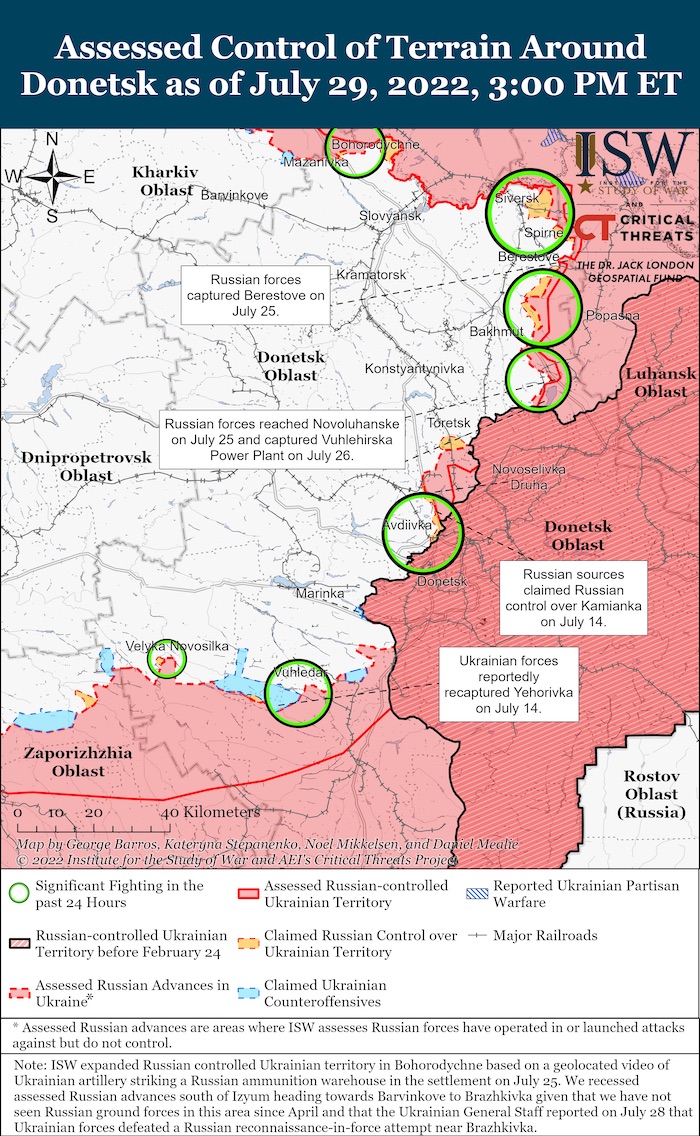
- In the Kramatorsk direction, shelling was recorded near Kramatorsk, Siversk, Spirne and other settlements. There were airstrikes near Serebryanka and Spirne. Russian forces continued conducting aerial reconnaissance by UAVs. [Yesterday, Russian forces shelled, in particular, the districts of Siversk, Ivano-Daryivka, Kryva Luka, Serebryanka, Hryhorivka, Zvanivka, Spirne, and Viimka. The airstrike was recorded near Serebryanka and Spirne. A reconnaissance group of the occupiers was discovered near Verkhnokamyanske, fire damage was inflicted on them, and the group retreated. Russian forces also carried out aerial reconnaissance by UAVs.]
- In the Bakhmut direction, Russian forces shelled military and civilian infrastructure in the areas of Yakovlivka, Soledar, Bakhmut, Vesela Dolyna, Kodema, Semyhirya, Travneve, Zaytseve, Kostiantynivka, and New York. Launched an airstrike near Soledar. It conducted assaults in the areas of Vershyna and Travneve, without success. Fighting continues near Semihirya, Zaytseve and Vershyna. [Yesterday, Russian forces shelled military and civilian infrastructure with artillery and tanks in the areas of Shumy, Kodema, Soledar, Bakhmut, Vesela Dolyna, Travneve, Zaitseve, Vershina and other settlements. Airstrikes near Pokrovske, Novoluhanske, Soledar and Vesela Dolyna.]
- [The occupiers again tried to storm the Soledar, Vershyna and Semihirya And again without success - they suffered losses and retreated.]
- In the Avdiivka direction, the occupiers shelled the districts of Novobakhmutivka, Avdiivka, Opytne, Vodyany, Pisky and Krasnohorivka with tanks, artillery and MLRS. Airstrikes were carried out near Selidove, Avdiivka and Pervomaiske. Russian forces carried out assaults in the areas of Pisky and Avdiivka, without success. Fighting continues near Krasnohorivka. [Yesterday, Russian forces shelled the areas of Pavlivka, Avdiivka, Vesele, Vuhledar, Vodyane, Velyka Novosilka, Pisky, Novokalynove, Krasnohorivka, Shevchenko and others.]
- [Yesterday, our soldiers decisively suppressed all offensive and assault actions of the occupiers in the Avdiivka, Kamianka, Krasnohorivka and Pisky]
- In the Novopavlivsky direction, Russian forces carried out artillery shelling in the areas of Mariinka, Vuhledar, Mykilske, Pavlivka, Vremivka, Novosilka and Novopil settlements. He conducted assault operations in the Mariinka area, was unsuccessful, and withdrew. Fighting continues near Pavlivka.
- In the Zaporizhzhia direction, Russian forces are shelling civilian and military infrastructure in the areas of Zaliznychne, Charivne, Bilohirya, Orihiv, Novoandriivka and Kamianske settlements. Conducted an airstrike near Novomykhailivka and Mali Shcherbaky.
In the Pivdenny Buh direction, Russian forces are concentrating their main efforts on holding the occupied positions and preventing the advance of our troops. Supports the high intensity of aerial reconnaissance by UAVs.
- Conducted systematic shelling of civilian and military infrastructure in the areas of Trudolyubivka, Osokorivka, Tokarevo, Karierne, Ivanivka, Lozove, Velyke Artakove, Kobzartsi, Shevchenkove, Shyroke, Posad-Pokrovske, Ukrainka, Partyzanske, Mykolaiv and Dniprovske settlements. Airstrikes near Novohrihorivka and Andriivka.
- [Yesterday, Russian forces shelled civilian and military infrastructure in the areas of Ivanivka, Tokarevo, Karierny, Osokorivka, Blagodatny, Kobzartsi and more than thirty other settlements.]
- Conducts active measures to restore logistical support.
In the waters of the Black Sea, the Black Sea Fleet continues to conduct reconnaissance and isolate the area of hostilities. Warships with "Kalibr" cruise missiles continue to rotate in the waters of the Black Sea to launch missile strikes on infrastructure facilities on the territory of Ukraine.”
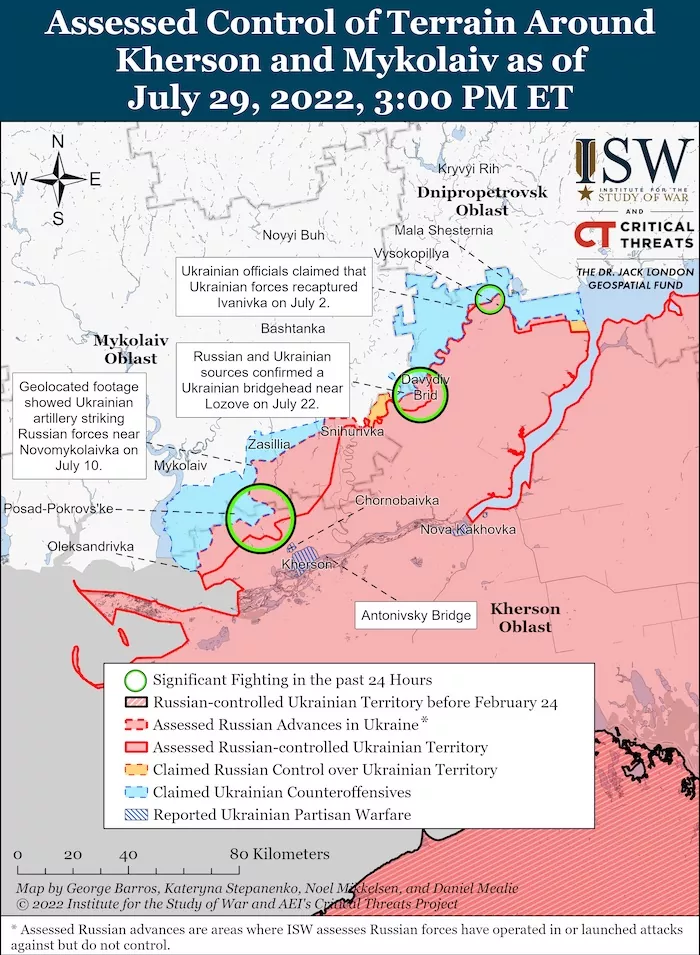
Russia moves military equipment towards Kherson and Crimea – the mayor of Melitopol, Ukrainska Pravda reports. "We have been observing military equipment transiting through Melitopol for the fourth day in a row. Three to four convoys are passing daily. The Russians are going through the city centre as well as through the suburbs; each convoy comprises 20 to 30 pieces of equipment. These are various types of weapons: from tanks to amphibious assault vehicles and infantry fighting vehicles. There are also just armoured weapons and infantry troops.
In particular, residents of Melitopol noticed the Buk-M2 surface-to-air missile system yesterday. According to Fedorov, all equipment and manpower are heading towards Kherson and Crimea from Donbas, Mariupol and Berdiansk.”
Military Updates
UN and ICRC should immediately respond to Russian terrorist act in Olenivka - Zelenskyy at meeting with Ukrainian defenders
"There is enough evidence that it was a planned crime. And this is another confirmation that Russia is a terrorist state" https://t.co/D6k0kYBDac
— Euromaidan Press (@EuromaidanPress) July 29, 2022
Ukrainian Armed Forces blow up Russian ammunition depots in Ilovaisk and Brylivka, Ukrainska Pravda reported Friday. The Directorate for Strategic Communications has reported that the Armed Forces of Ukraine have struck Russian ammunition depots in Ilovaisk (Donetsk Oblast) and Brylivka (Kherson Oblast).
Ukrainian Armed Forces destroy 4 Russian ammunition depots in Kherson Oblast, Ukrainska Pravda reported Friday, citing Operational Command South. The Armed Forces of Ukraine have destroyed four Russian ammunition depots in the Henichesk, Kherson, Kahovka and Beryslav districts of Kherson Oblast.
Russia launched 49 missiles and 44 air strikes on Ukraine in July, Ukrinform reports, citing Oleksiy Hromov, Deputy Chief of the Main Operations Department of the General Staff of the Armed Forces of Ukraine. "Since the beginning of the month, Russian forces launched 49 missiles attacks and 44 air strikes, completely destroying 28 objects, including 4 schools and 9 residential buildings, and partially destroying 137 objects, including 7 transport infrastructure facilities, 11 educational institutions and 29 residential buildings, Hromov said.”
https://twitter.com/EuromaidanPress/status/1552993431085088768
Ukraine’s Armed Forces liberated three settlements in the Kherson region over the past two weeks, Ukrinform reports. “Our military units and subdivisions continue to gradually liberate the Kherson region from the Russian occupying forces. Over the past two weeks, Ivanivka and Lozove were liberated. Andriivka has been liberated this week, Hromov said.”
Russians set up pontoon, ferry near critical bridges destroyed by Ukraine near Kherson, satellite images show
Kherson Obl Administ says occupiers charge 250 UAH to use the ferry, set up near Antonivskyi road bridge. Pontoon crossing made near rail bridgehttps://t.co/GmyuwICZEQ pic.twitter.com/ppz4Qg8bYo
— Euromaidan Press (@EuromaidanPress) July 29, 2022
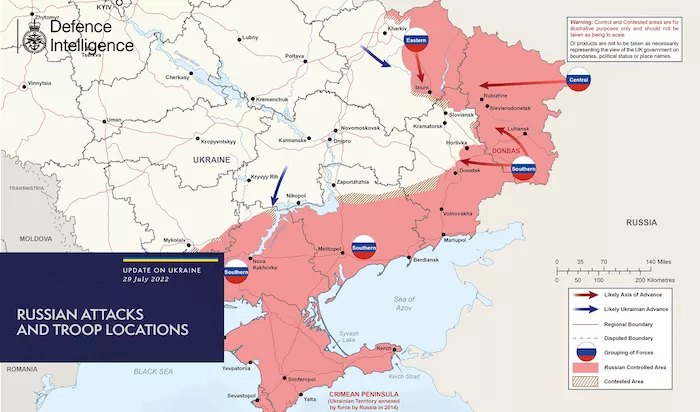
According to British Defence Intelligence, (last 48 hours):
- It is likely that Ukraine has successfully repelled small-scale Russian assaults from the long-established front line near Donetsk city in the Donbas. In the Kherson area, Russian forces have highly likely established two pontoon bridges and a ferry system to compensate for the fact that nearby bridges have been damaged in recent strikes.
- Across the newly occupied territories in southern Ukraine, Russian-installed authorities are highly likely under increasing pressure from Moscow to consolidate their control over the region and prepare for referendums on joining Russia later in the year. Russia currently classes the occupied areas as under interim ‘civil-military administration’. Local authorities are likely coercing the population into disclosing personal details in order to compose voting registers.
- Since March, the Russian private military company (PMC) Wagner Group has operated in eastern Ukraine in coordination with the Russian military. Wagner has likely been allocated responsibility for specific sectors of the front line, in a similar manner to normal army units.
- This is a significant change from the previous employment of the group since 2015 when it typically undertook missions distinct from overt, large-scale regular Russian military activity.
- This new level of integration further undermines the Russian authorities’ long-standing policy of denying links between PMCs and the Russian state. Wagner’s role has probably changed because the Russian MoD has a major shortage of combat infantry, however, Wagner forces are highly unlikely to be sufficient to make a significant difference in the trajectory of the war.
Losses of the Russian army
As of Saturday 30 July, the approximate losses of weapons and military equipment of the Russian Armed Forces from the beginning of the war to the present day:
- Personnel – more than 40670 (+170),
- Tanks – 1759 (+10),
- Armoured combat vehicles – 3995 (+8),
- Artillery systems – 906 (+6),
- Multiple rocket launchers –MLRS - 258 (+0),
- Air defence means – 117 (+0),
- Aircraft - 222 (+0),
- Helicopters - 190 (+0),
- Automotive technology and fuel tanks – 2889 (+19),
- Vessels/boats - 15 (+0),
- UAV operational and tactical level – 733 (+2),
- Special equipment – 78 (+1),
- Mobile SRBM system – 4 (+0),
- Cruise missiles – 174 (+0)
Russian enemy suffered the greatest losses (of the last day) in the Donetsk direction.
More than 75,000 Russians have been killed or wounded, US lawmakers told, CNN reports. “We were briefed that over 75,000 Russians have either been killed or wounded, which is huge, you've got incredible amounts of investment in their land forces, over 80% of their land forces are bogged down, and they're tired,” Rep. Elissa Slotkin of Michigan, a Democrat who serves on the House Armed Services Committee and recently visited Ukraine, told CNN.”
Russia introduces further measures to solve manning problems, the Defence Intelligence of Ukraine (DIU) reports. To fill vacancies, they have started to promote non-commissioned officers en mass to the rank of junior lieutenant without relevant experience and education.
Another reason for the shortage of personnel is the reluctance of servicemen of the Armed Forces and the National Guard from the Far Eastern regions to participate in military operations on the territory of Ukraine. Because they are often included in the composition of the so-called "combined units", which are not formed based on a professional basis. As a result, a large number of soldiers lack proper training, which leads to additional losses.
Many occupiers who participated in hostilities do not want to return to their units, citing health problems as the reason for their refusal. In order to prevent the "drain of personnel", the leadership of the Armed Forces of the Russian Federation is forming military medical commissions. Their main task is to identify servicemen who fake illnesses and injuries to avoid participating in combat operations.
On the territory of the Rostov region, in small settlements, active mobilization training for conscripts is taking place. Regional military commissariats recruit young people who have served in the military and have artillery experience. Persons who served in the infantry are enrolled in the military reserve. They are informed about the need to arrive on call for the rotation of servicemen currently participating in the war against Ukraine (specific terms are not announced). Currently, seven to ten local residents have been called up for military service from almost every village in the Rostov region.”
⚰️russia's combat losses in Ukraine as of July 30
▪ 40670 killed soldiers (+170)
▪ 3995 APV (+8)
▪ 1759 tanks (+10)
▪ 906 artillery systems (+6)
▪ 222 aircraft and 190 helicopters
▪ 15 boats and cutters#StopRussia #StandwithUkraine pic.twitter.com/rbN8v6puDE— VoxUkraine (@voxukraine) July 30, 2022
Humanitarian
Millions of refugees from Ukraine have crossed borders into neighbouring countries, and many more have been forced to move inside the country. The escalation of conflict in Ukraine has caused civilian casualties and destruction of civilian infrastructure, forcing people to flee their homes seeking safety, protection and assistance the UNHCR reports. As of 26 July:
| Individual refugees from Ukraine recorded across Europe: | 6,162,309 |
| Belarus, Hungary, Republic of Moldova, Poland, Romania, Russian Federation, Slovakia | 3,399,486 |
| Other European countries | 2,762,914 |
| Refugees from Ukraine registered for Temporary Protection or similar national protection schemes in Europe: | 3,744,925 |
| Hungary, Poland, Romania, Slovakia | 1,408,647 |
| Other European countries | 2,336,278 |
| Border crossings from Ukraine (since 24 February 2022): | 9,926,884 |
| Border crossings to Ukraine (since 28 February 2022): | 3,995,658 |
https://twitter.com/EuromaidanPress/status/1553213796222750720
OHCHR recorded 12,272 civilian casualties in Ukraine as of July 25. 5,237 were killed (including 348 children) and 7,035 injured (including 560 children).️️
Environmental
Ten ships loaded with grain are ready to leave ‘Odesa’ and ‘Chornomorsk’ ports, Ukrinform reports. "Today, the delegation of the Ministry of Infrastructure together with President of Ukraine Volodymyr Zelensky, ambassadors of G7 countries, Türkiye, and UN representatives inspected the process of loading the first ships within the framework of the ‘grain’ initiative sealed in Istanbul. In particular, 17 ships have already been loaded in ‘Odesa’ and ‘Chornomorsk’ ports, ten of which are ready to leave, the press service of the Ministry of Infrastructure of Ukraine posted on Telegram. Grain exports will begin with several ships that had been loaded but were unable to leave port due to the onset of Russia’s full-scale invasion.”
https://twitter.com/EuromaidanPress/status/1552987087842037760
The cost of insurance for ships with Ukrainian grain will increase hundreds of times, Ukraine Business News reports. “Lloyd’s of London and other brokers are preparing to insure grain shipments from Ukraine, said the head of the commercial insurance market, Bruce Carnegie-Brown. He said that brokers and underwriters should announce individual programs in the coming days. Premiums for entering the vast Black Sea area have increased dramatically, to 5% of a ship’s cost, up from 0.025% before the invasion. Brokers have already shown interest in insuring vessels passing through the grain corridor. However, they are ready to do this only on the condition that international naval escorts will be present and a clear strategy for combating sea mines will be organized.”
Ukrainian farmers have their doubts about an international agreement to ease a blockade on grain shipments through the Black Sea, The New York Times reports. “But despite fanfare in Brussels and Washington, the accord is being greeted cautiously in the fields of Ukraine. Farmers who have lived for months under the risk of Russian missile attacks and economic uncertainty are skeptical that a deal will hold. […]
A missile strike on Saturday that hit Odesa, Ukraine’s biggest Black Sea port, jolted confidence in the deal and risked undermining the effort before the agreement could even be put into action. No one believes Russia won’t attack again, said Vasyl Levko, the director of grain storage at MHP, one of Ukraine’s largest agricultural production companies. […]
Yet even when reopened, the Black Sea ports are expected to operate at just about half of their prewar capacity, experts say, covering only a portion of the more than 20 million tons of backlogged grain. Ships will steer through a path cleared of Ukrainian mines used to prevent Russian ships from entering, and endure inspections in Türkiye to ensure they don’t carry weapons back into Ukraine. […]
In the meantime, Ukraine’s farmers are grappling with vast amounts of trapped grain from last year’s harvests. […] An additional estimated 40 million tons — of wheat, rapeseed, barley, soy, corn and sunflower seeds — is expected to be harvested in the coming months. Storage facilities not destroyed by Russian shelling are filling up, and room is growing scarce for the freshly reaped crops. […]
After the wheat comes the corn harvest. That will have to be piled onto the ground and covered with a tarp to protect it from thousands of crows and pigeons that hover nearby like black clouds, as well from as the autumn rains, which can create rot, Mr. Levko added. The crops will have to be stored everywhere, he said, sweeping his arm over a vast field. He added that even if the deal to unblock the Black Sea worked, it could take months for Odesa’s shipping capacity to help ease the grain pileup.
In the meantime, farmers are trying to expand an alternative labyrinth of transport routes that they have forged across Europe since the outbreak of the war. Before Russia’s blockade, Ukraine exported up to seven million tons of grain a month, mostly on ships that can carry large loads. Since then, Ukraine has been able to get out only around two million tons per month, via a hastily cobbled patchwork of overland and river routes. […]
The blockade forced the company to put some of its grain on a circuitous path that involves making a giant counterclockwise circle around Europe on trucks, trains, barges and ships via Poland, the North Sea and the English Channel, through the Strait of Gibraltar and back down to the Mediterranean, an odyssey that can take up to 18 days.
With so many exporters competing to get grain out of Ukraine, the cost of transporting it has ballooned to about $130 to $230 a ton from about $35 before the war, with eastern regions near Russian-occupied zones facing the sharpest price hikes, Mr. von Nolcken added. At the same time, grain prices within Ukraine have plunged by around two-thirds because the blockade left farmers holding too much grain, threatening the livelihood of many.
European countries have been working furiously to solve one of the biggest challenges: transporting grain by rail. Previously, Ukraine’s 38,000 grain cars carried crops mostly to Black Sea ports, but they run on Soviet-era tracks that don’t match Europe’s. So rail shipments heading elsewhere must now be transferred to other trains once they reach the border.
The biggest opportunity for scaling up exports is with trucks. Roman Slaston, the head of Ukraine’s main agricultural lobby, said his group was aiming to get out 40,000 tons of grain per day by truck. By June, trucks were getting out 10,000 tons per day.
With so many trucks trying to get Ukraine’s grain out, border crossings have become jammed. […]And with so much added traffic on the road, border crossings are jammed. It now takes four days — instead of four hours, before the war — for grain trucks to cross from Ukraine to Poland, said Mr. Levko of MFP. Getting over the Serbian border takes 10 days instead of two. The European Union is trying to ease backups with fast-track border permits. […]
We are building up a tsunami of grain, producing more than we can export, Mr. von Nolcken added. “We will still be sitting on crops that won’t get out.”
Legal
https://twitter.com/EuromaidanPress/status/1553120679507087360
Russians announce 53 Ukrainian prisoners dead – Ukrainian MoD Intelligence says Russia is responsible, Ukrainska Pravda reports, citing TASS, and Ukrainska Pravda sources in intelligence and law enforcement agencies. “On the morning of 29 July, Russian-aligned propaganda media announced the shelling of a penal colony in Olenivka, Donetsk Oblast, where Ukrainian prisoners are being held. Ukrainska Pravda sources note that the blow to the Ukrainians was struck by Russia.
Russian propagandist media are claiming that allegedly the Armed Forces of Ukraine targeted the barracks where captured Ukrainian soldiers are being held. Kremlin-aligned Russian media outlet RIA Novosti [wrote that 53 were killed and 75 injured]. The Russians write that the Armed Forces of Ukraine hit the colony to kill prisoners who had "begun to testify." What exactly the "testimony" is about is unknown."
EU condemns Russia killing Ukrainian POWs in Olenivka "in strongest possible terms" - top diplomat Borrell https://t.co/dNyoJ97911
— Euromaidan Press (@EuromaidanPress) July 29, 2022
Russians struck Olenivka to cover up the torture and execution of prisoners, Ukrainska Pravda reports, citing the General Staff of the Armed Forces of Ukraine. “It reports that Russia shelled the penal colony in Olenivka, Donetsk Oblast, to cover up the torture and murders of Ukrainian prisoners of war, as well as to accuse the Armed Forces of Ukraine of committing "war crimes".”
SSU interception confirms: The shelling of Olenivka prison was carried out by occupiers (audio), Security Service of Ukraine (SSU) claims. “The SSU has intercepted telephone conversations in which occupiers confirm that Russian troops are to blame for this tragedy. Even the militants of the so-called DNR do not believe in the lies of Russian propaganda that the ‘shelling’ of the correctional facility in Olenivka was carried out by Ukraine.”
Joint Statement on the Mass Murder of Ukrainian Prisoners of War on July 29, 2022, in the Village of Olenivka in the Temporarily Occupied Territory of Donetsk Region. Joint statement by the Armed Forces of Ukraine, the Security Service of Ukraine, the Main Intelligence Directorate of the Ministry of Defense of Ukraine and the Human Rights Commissioner of the Verkhovna Rada of Ukraine.
On the night of July 29, on the territory of former penal colony No. 210, in Olenivka, in the temporarily occupied territory of the Donetsk region, an explosion occurred, destroying the building in which Ukrainian prisoners of war were kept. According to the Russians, more than 50 Ukrainian defenders were killed, the number of wounded is unknown. According to the comments of the Russian side, not a single employee of the colony, "DNR" fighter or Russian military man who was guarding the premises was injured in the explosion. Immediately after the explosion, Russia accused Ukraine of shelling the penal colony with US weapons and killing Ukrainian soldiers. In this regard, we declare the following:
- The committed explosion is a cynical terrorist act of the Russian Federation, a military provocation and a typical false flag operation, the purpose of which is to cover up war crimes, discredit the Armed Forces of Ukraine, disrupt the supply of Western weapons and increase social tension in Ukrainian society.
- The Armed Forces of Ukraine attack only Russian military facilities: warehouses with fuel, weapons and ammunition, command posts, and military infrastructure facilities. The Ukrainian army has enough means to identify targets, including space reconnaissance systems. Ukraine did not fire rockets and artillery at the village of Olenivka.
- On May 16, with the mediation of the UN and the International Committee of the Red Cross, the process of evacuating the defenders of Mariupol from the territory of the Azovstal plant, which was surrounded and was under attack by Russian troops for a long time, began. The format of the evacuation provided for the establishment of a ceasefire and the surrender of the Ukrainian military as prisoners, with subsequent swaps under the guarantees of the UN and the International Committee of the Red Cross. This format was chosen and approved by the defenders of Mariupol, who participated in the negotiations. On June 29, the first of the planned swap of prisoners of war took place, returning 144 defenders to Ukraine. Among them are 95 Azovstal defenders.
- The key condition of the chosen format was the obligations of the Russian side to international organizations regarding the preservation of the life and health of Ukrainian defenders. This guarantee was cynically violated.
- On the night of July 29, on the territory of the former penal colony of the village of Olenivka the organized killing of Ukrainian prisoners of war took place. Many documented evidences prove the planned nature of this crime and its commission by the Russian side: in particular, the deliberate transfer of fighters to new premises shortly before the explosion, analysis of the nature of the damage and the movement of the blast wave, interception of the militants' telephone conversations, the absence of shelling in the specified place, and others. All this leaves no doubt: the explosion in Olenivka was a Russian terrorist act and a gross violation of international agreements.
Considering the above, WE DEMAND:
- From the United Nations and the International Committee of the Red Cross, which acted as guarantors of the life and health of Ukrainian prisoners of war, to immediately respond to the terrorist act committed by the Russian Federation.
- Immediately send representatives of the United Nations, the International Committee of the Red Cross, the Human Rights Commissioner of the Verkhovna Rada of Ukraine, and representatives of the Joint Center for Search and Release of Prisoners to the territory of the colony in the village of Olenivka in the temporarily occupied territory of Donetsk region with the purpose of an inspection mission.
https://twitter.com/EuromaidanPress/status/1553020967928168450
"Azov" announces a hunt for everyone involved in the mass murder of prisoners in Olenivka, Ukrainska Pravda reports, citing Andriy Biletskyi, founder of the Azov Regiment and leader of the National Corps party. “Units of the Azov Regiment announced a hunt for all [Russians] involved in the mass murder of Ukrainian prisoners of war in Olenivka on 29 July.”
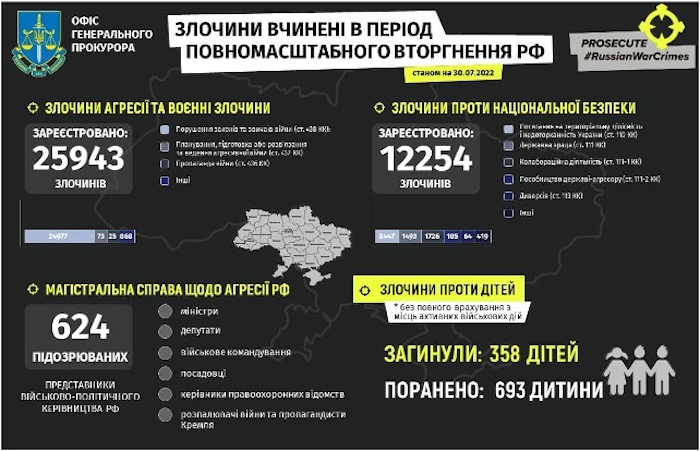
358 children were killed, and 693 children injured, the Office of the Prosecutor General of Ukraine reports as of July 30. 2,197 educational establishments are damaged as a result of shelling and bombings, 223 of them are destroyed fully. 25,943 crimes of aggression and war crimes and 12,254 crimes against national security were registered.
Support
The US is to announce another military aid package for Ukraine very soon - White House, Ukrinform reports. “I fully expect that and I think you’re going to see another one [military aid package] relatively soon,” John Kirby, the National Security Council Coordinator for Strategic Communications, announced at a briefing on Friday Kirby.
The White House representative said he would not specify any dates now, however, according to him, another statement on the security assistance support for Ukraine would be announced "very soon." Commenting on what would be included in the new package, Kirby said that “you can expect to see things in line with the kinds of security assistance you’ve seen in the past.”
Germany to supply 16 Biber bridge-layer tanks to Ukraine
The bridge-laying tanks Biber serve to cross water and gorges. The rapid armored bridge is 22 meters long, 4 meters wide and it takes 2 to 3 minutes to lay it down. https://t.co/iipg5fZ7w4https://t.co/01Sai5r9Xs
— Euromaidan Press (@EuromaidanPress) July 29, 2022
Germany sends 16 armoured bridge layers to the Ukrainian army, Ukrinform reports. "We continue to support! Minister Lambrecht adopted a decision to send 16 Biber armoured bridge layers to further support the Land Forces of Ukraine. They can be used to overcome water and other obstacles during the battle, the Ministry of Defense of Germany posted on Twitter.”
As they wait for weapons, Ukrainians hold the line with Soviet artillery, The Washington Post reports. “While Western countries have started sending better weapons to Ukraine, they can be slow to arrive, leaving some units, like Pirbudagov’s 128th Separate Mountain Assault Brigade, to fight with Soviet-era leftovers. They require a lot of repairs, he said, and parts that aren’t easy to find. On the other side of the front line, Pirbudagov’s enemy is often using the same kind of howitzer, but it’s 15 years newer and has a bigger gun.
The new artillery systems tend to go to artillery brigades or to higher-priority locations, such as eastern Ukraine’s Donbas region, where fighting has been most intense. But the disparity between military units is also the result of Ukraine still waiting on much of the weaponry it has been promised.
The United States and Germany, for example, had as of July 1 delivered less than half of the military aid they have announced, according to data from the Kiel Institute for the World Economy, which has been tracking countries’ contributions and deliveries of weapons to Ukraine.
While Ukrainian officials are grateful for any security assistance — Washington alone has provided more than $8 billion since the start of the Biden administration, with billions more to come — they’ve also voiced frustration with the delays during a critical juncture of the war when Moscow appears vulnerable. Richard Moore, the chief of Britain’s intelligence service, said last week that Russia is likely to “run out of steam” in the coming weeks, amid shortages of manpower and materiel. […]
With Russia’s troops stretched along a vast front that spans most of Ukraine’s eastern and southern boundary, the Ukrainians have had the most success reclaiming territory along the southern axis — a counteroffensive that’s vital to improving Ukraine’s position in any future negotiations on an end to the conflict.
But Pirbudagov and other soldiers in his self-propelled artillery unit near the front line in the southeastern Zaporizhzhia region said they are unable to advance with the weapons they have — the best they can do is hold their current position. Pushing the Russians back by just five miles over two months would be considered good progress. […]
The war has become a cat-and-mouse game between artillery units. Each side uses drones for reconnaissance, which identify targets for attack. For the Ukrainians, that means keeping their weapons constantly camouflaged and moving quickly. Their main Russian targets are artillery and ammunition depots — anything that will make a dent in Moscow’s significant weapons advantage. Russia’s modern howitzers have systems that can automatically correct for terrain and weather factors, making them more accurate than Ukraine’s, which have to be adjusted manually.
Ukrainians stuck with Soviet-era artillery are also running short on ammunition because the older howitzers use different calibre rounds that are scarcely produced outside Russia. That means Ukrainian soldiers must be more selective with their targets, while Russian forces can fire indiscriminately — up to five times as much […].”
Over UAH600M has already been raised for Ukraine’s “Drone Army”, Ukrinform reports. "Our task is to provide the Army with such a number of drones that there are enough of them on each line of resistance and defence. To date, we have already collected more than UAH 600 million for these projects, as well as contracted large batches of relevant equipment, [Deputy Prime Minister, Minister of Digital Transformation Mykhailo Fedorov9 said. According to the minister, the fundraising campaign continues in order to systematically purchase and distribute UAVs along the entire front line.”
81% of Ukrainians would support joining the EU in a referendum, and 71% joining NATO – poll, Ukrainska Pravda report, citing a survey conducted by Kyiv International Institute of Sociology (KIIS), conducted 6-20 July. "In the event of a referendum on joining the EU, 81% of all respondents would vote ‘for’ joining. 4% would be ‘against’ joining the EU. The rest (15%) would not participate in the vote or do not know how to vote. There is slightly less support for joining NATO, but also the overwhelming majority of Ukrainians would vote ‘yes’ – 71% of all respondents."
The sociologists emphasise that in terms of respondents who would have taken part in the expression of their will, 96% of the votes would have been in favour of the referendum on joining the EU, and 91% of the votes would have been in favour of the referendum on joining NATO. It is noted that joining the EU and NATO is supported in all regions, although there is a tendency for support to lessen from west to east.”
Ukraine Official Says Country Doesn't Want Old American A-10s, Military.com reports. “Air Force officials said last week that a variety of American planes could be given to Ukrainian pilots in their fight against Russia, including the A-10 Warthog. But in a message to Military.com on Tuesday, Yuriy Sak -- an adviser to Ukraine's minister of defence -- made it clear: The country doesn't need A-10s, it needs the more modern F-16 Fighting Falcon fighter jet.
The A-10s "will not close our sky, they will not stop bombers and missiles, Sak said in a message. "They will be a target for Russian jet fighters and anti-aircraft defence because we don't have the means neither to effectively cover them nor to break through Russian forces anti-aircraft defence. US military officials and the Ukrainian Ministry of Defence are in ongoing talks about which modern aircraft would best help the country repel invading Russian forces and also help build its air force for future protection against adversaries.”
Hungary's Orban expects a gas deal with Russia this summer, Reuters reports. “Hungary expects to sign a deal with Russia on additional gas shipments of 700 million cubic metres by the end of summer, Prime Minister Viktor Orban told state radio on Friday. The two countries have been in talks for further supplies on top of an existing long-term supply pact. European Union member Hungary has maintained what it calls pragmatic relations with Moscow since Russia's invasion of Ukraine, creating tensions with some EU allies keen to take a tougher line. Hungary, which is about 85% dependent on Russian gas, firmly opposes the idea of EU sanctions on Russian gas imports.”
https://twitter.com/EuromaidanPress/status/1553027566121934849
New Developments
- The US Senate passes a resolution seeking to label Russia as a sponsor of terrorism, The New York Times The Senate unanimously approved a nonbinding resolutionon Wednesday calling for Secretary of State Antony J. Blinken to designate Russia as a state sponsor of terrorism for actions in Chechnya, Georgia, Syria and Ukraine that resulted “in the deaths of countless innocent men, women and children. A similar measure had been introduced in the House. However, the power to designate a state sponsor of terror resides with the State Department. Nevertheless, the Senate’s passage of the resolution puts yet more congressional pressure on the Biden administration to add Russia to a list of state sponsors of terrorism that includes Cuba, North Korea, Iran and Syria.”
- Statement by the High Representative Josep Borrell on the latest Russian atrocities. “Russia’s ongoing illegitimate and unjustified war of aggression against Ukraine and its people brings further horrific atrocities day by day. Today in Olenivka, in eastern Ukraine, Russia is reported to have killed dozens of Ukrainian prisoners of war, including defenders of Mariupol’s Azovstal steel plant, who surrendered to Russia, were registered by the ICRC in May and were in Russia’s legal protection under international humanitarian law.
Evidence in form of appalling video footage has been widely shared on pro-Kremlin social networks today, in which Russian soldiers commit a heinous atrocity against a Ukrainian prisoner of war.
The European Union condemns in the strongest possible terms the atrocities committed by the Russian armed forces and their proxies. These inhumane, barbaric acts represent severe breaches of the Geneva conventions and their Additional Protocol and amount to war crimes. The perpetrators of war crimes and other serious violations, as well as the responsible government officials and military representatives, will be held accountable.”
- The US to react to any annexation attempts by Russia - a statement at UN, Ukrinform “The United States, along with its allies and partners in the United Nations, will react to any attempts on the part of Russia to annex new territories in Ukraine. This will be done to protect the world order and the UN charter. That’s according to Linda Thomas-Greenfield, the US Ambassador to the UN, who addressed the UN Security Council on Friday, July 29. We cannot, we will not stand by and let it happen, Thomas-Greenfield said. Russia has effectively set the UN Charter on fire, the US ambassador emphasized.”
- DNR may hold a referendum on accession to Russia in mid-September — civic chamber head, TASS reports. “Donetsk People’s Republic (DNR) may hold a referendum on accession to Russia in mid-September, says DNR Civic Chamber chairman Alexander Kofman. According to our military commanders, the DNR territory will be completely “liberated” of the Ukrainian army by late August; so, probably, [the referendum will take place in] mid-September," he told TASS Wednesday, answering a question. Kofman also noted that "it would be better" to hold the referendum on the same day with the similar referendum in Luhansk People’s Republic.”
- Austrian president: Putin waging imperialist war, Ukrainians protecting our values, Ukrinform “Austrian President Alexander Van der Bellen has said that Ukrainians who are fighting against Russian aggression are also fighting for "our values, peace and freedom." He said this in a speech at the opening of the 2022 Salzburg Festival. Our freedom and the entire model of our coexistence are being put to the test. Our democracy is under attack. With high aggression and destructiveness. We have another war in Europe. Women, men, children, families are killed, he said.”
https://twitter.com/EuromaidanPress/status/1553189130456154112
Assessment
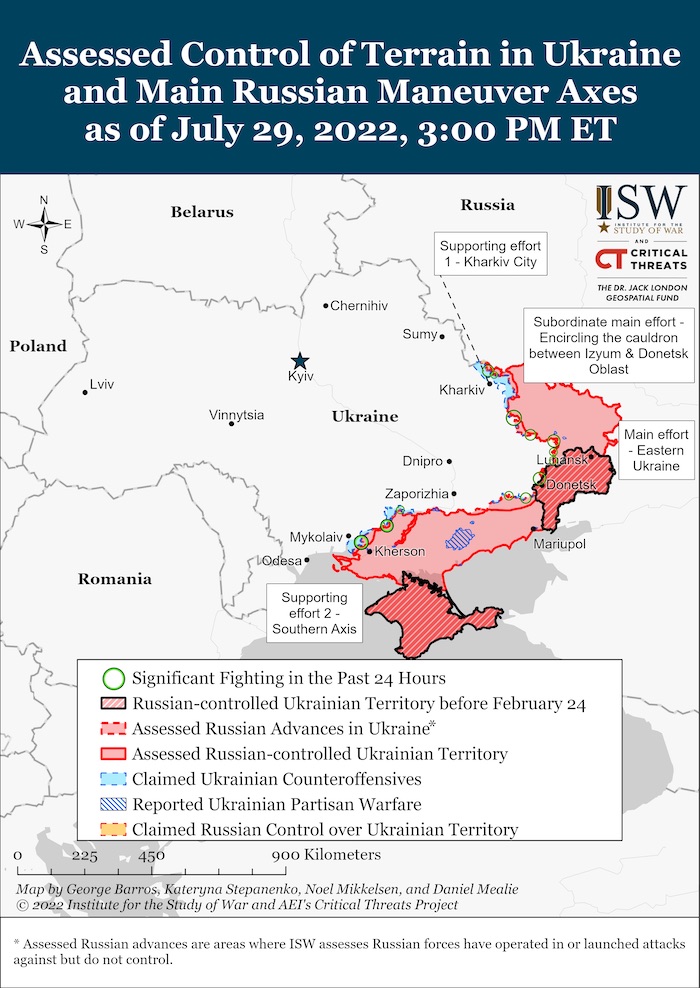
- On the War
The Institute for the Study of War has made the following assessment as of Friday 29 July:
“A kinetic event killed and wounded scores of Ukrainian POWs in Russian-occupied Olenivka, Donetsk Oblast, on July 28. Ukraine and Russia are blaming each other for the attack and available visual evidence appears to support the Ukrainian claim more than the Russian, but ISW cannot independently assess the nature of the attack or the party responsible for it at this time. The Russian Defense Ministry asserted that Ukrainian forces deliberately struck the Olenivka pre-trial detention center holding Ukrainian POWs including Azov Regiment servicemen using Western-provided HIMARS, killing at least 40 and wounding 75 POWs. Kremlin-sponsored news outlet “RIA Novosti” published videos of the detention center, which showed fire damage but not the sort of damage that a HIMARS strike would likely have caused. RIA Novosti also released footage of HIMARS missile fragments but provided no evidence that the fragments were recovered at Olenivka. Luhansk People’s Republic (LNR) Ambassador to Russia Leonid Miroshnik claimed that Ukrainian forces struck the pre-detention center to eliminate the evidence of Ukrainian surrenders and prevent POWs from speaking out against the Ukrainian government.
The Ukrainian General Staff said that Russian forces conducted the attack as a false flag operation to cover up Russian war crimes, disrupt the supply of Western weapons, discredit Ukrainian forces, and stoke social tensions within Ukrainian society. The Ukrainian General Staff stated that a deliberate explosion occurred near the newly-constructed penal colony, to which Russian forces had transferred Ukrainian POWs a few days earlier. The Ukrainian General Staff also noted that Ukrainian analysis of the damage to the building, intercepted phone conversations between Russian servicemen, the lack of reported shelling in Olenivka, and the absence of casualties among Russian personnel serving at the penal colony all point to a Russian deliberate “terrorist act” as the cause of the incident. The Ukrainian Main Military Intelligence Directorate (GUR) accused Wagner Group head Yevgeny Prigozhin of ordering the “terrorist act” without consulting with the Russian Defense Ministry, to conceal the embezzlement of funds allocated for the maintenance of Ukrainian POWs before an official inspection on September 1. The Ukrainian Office of the General Prosecutor reported that the explosion killed at least 40 and wounded 130 Ukrainian POWs.
ISW is unable to assess the nature of the event or the party responsible for it with any confidence at this time. We will update our assessment as more information becomes available.
Key Takeaways
- A kinetic event killed and wounded scores of Ukrainian POWs in Russian-occupied Donetsk Oblast on July 28. Ukraine and Russia are blaming each other for the attack. Available visual evidence appears to support the Ukrainian claim more than the Russian, but ISW cannot independently assess the nature of the attack or the party responsible for it at this time.
- Ground fighting continued north of Kharkiv City with no significant change in control of terrain.
- Russian forces attempted a limited ground assault in Kherson Oblast and continued conducting combat operations without creating strike groups along occupied lines.
- Russian regional outlets reported the recruitment and establishment of an additional volunteer battalion in the Republic of Buryatia and the formation of a reserve battalion in Novosibirsk.
- Members of Russian President Vladimir Putin’s United Russia party traveled to occupied Ukrainian territories to promote an organization called “We Are Together with Russia,” likely to present the façade of a “grassroots” call for the Russian annexation of occupied Ukraine and to prepare for falsified annexation referenda.“
The situation on the battlefield has significantly turned in Ukraine’s favour – US general, Ukrinform reports. "I believe that if the West/US continues to deliver everything promised at a faster pace, then Ukrainian forces will be able to push Russian forces back to the February 23 line by the end of this year. The situation is already turning significantly in favour of Ukraine. I expect active hostilities to continue in the winter. Ukraine will probably want to keep up the pressure on Russian forces which I believe are exhausted... And the Russian logistics system is especially exhausted, Retired Lieutenant General Ben Hodges, the former commanding general of US Army forces in Europe, told RBC-Ukraine in an interview.”
Russia incapable of overthrowing Ukrainian government - Canadian intelligence, Ukrinform reports. That’s according to the Canadian Forces Intelligence Command. "Currently, Russia’s deployed forces in Ukraine are insufficient for it to achieve its stated objective of replacing the government in Kyiv, reads the tweet posted by the agency’s press service. It is noted that "Russia will continue to struggle to make even modest tactical progress on the eastern and southern fronts.
At the same time, the Russian Federation no longer has sufficient reserves to replenish its group operating in Ukraine. Almost all Russian Army units have been involved in combat in Ukraine. Russia has seen such high casualties across most of its Army units that it is struggling to even find untrained recruits to backfill deployed units, the report reads.”
Russia prepares to deploy a new strike force against Ukraine – Ukrainian Intelligence, Ukrainska Pravda reports, citing the press service for the Defence Intelligence of Ukraine. "According to verified information, 8 battalions have been formed by mid-July [to conduct hostilities in Ukraine - ed.]. This was not enough for the Russian Federation. These battalions have been formed haphazardly. Almost anyone could join them. Therefore, Russia decided to form the Third Separate Army Corps to conduct hostilities. It is currently undergoing training in the Western Military District. The Russians plan to complete the formation of the corps by mid-August.
The Ukrainian Intelligence has also found that there is a catastrophic shortage of officers in Russian units. The formation of the new army corps is intended, at least in part, to address this issue. Russia’s covert mobilisation efforts have failed.”
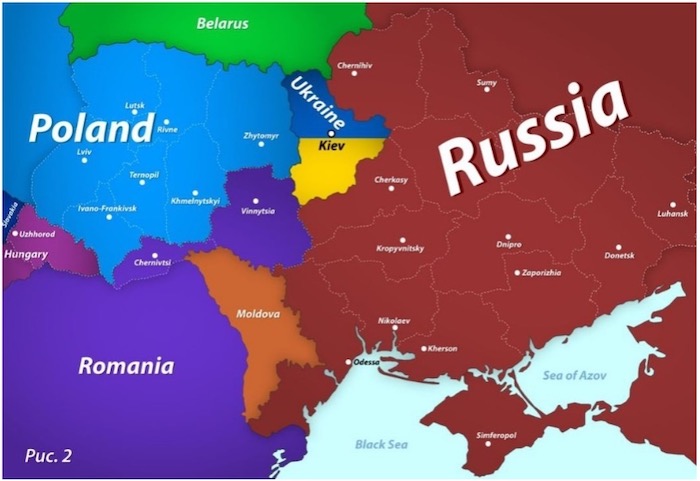
Medvedev once again dreams of the disintegration of Ukraine, publishing maps, Ukrainska Pravda reports. The Deputy Chairman of the Security Council of the Russian Federation, Dmytro Medvedev, continues to dream of the disintegration of Ukraine and has published a map of it with other countries. Medvedev published two maps of Europe: in one of them, Ukraine is shown divided into parts, with its territory being absorbed into other countries.
2. Consequences and what to do?
Inflation to reach 31% in 2022, GDP to drop by a third - National Bank, Ukrinform reports, citing the press service of the National Bank. "By the end of 2022, inflation will accelerate and reach 31% given the persistence of the impact of most supply shocks. This is, in particular, about the consequences of hostilities and the high cost of energy. In the next year, inflation is expected to slow down thanks to better inflationary expectations, the improvement of logistics, and the gradual growth of crops," the report says.
It is noted that an additional disinflationary effect will be a decrease in global inflation and the NBU’s tight monetary policy. Instead, the high cost of energy and the need to gradually increase household tariffs to market levels will restrain inflation slowdown. As a result, consumer inflation will decline to around 20% in 2023 and slow to single-digit levels only late 2024.”
The US is a lot stronger than Russia. We should act like it, Max Boot, a columnist at The Washington Post argues. The war in Ukraine has now entered its third phase.
[…] Ukrainian troops are holding a strong defensive position in neighboring Donetsk province (also part of Donbas) and effectively hitting back with High Mobility Artillery Rocket Systems and other longer-range weapons supplied by the West. The HIMARS, in particular, have been a game changer by allowing the Ukrainians to destroy more than 100 high-value targets such as Russian ammunition depots and command posts.
A Ukrainian battalion commander told The Post that since the HIMARS strikes began, Russian shelling has been “10 times less.” Another Ukrainian officer told the Wall Street Journal: “It was hell over here. Now, it’s like paradise. Super quiet. Everything changed when we got the HIMARS.” President Volodymyr Zelensky says Ukrainian fatalities are down from between 100 and 200 a day to 30 a day.
If Ukraine is able to fight back so effectively with only 12 HIMARS (soon to be 16), imagine what it could do with dozens more and, better still, Army Tactical Missile Systems (ATACMS), which use the same platform but have nearly quadruple the range. These rocket systems should be supplemented by Western tanks and fighter aircraft. If the West were to supply all these weapons, Ukraine could mount a counteroffensive to take back lost land in the south and east and help end the war.
The Biden administration is slowly supplying more HIMARS and, for the first time, is even discussing the provision of Western fighter aircraft (after nixing a Polish plan to send MiG-29s in March). But ATACMS appear to be off the table because, as national security adviser Jake Sullivan explained last week, the administration does not want to head “down the road towards a third world war.” Ukraine isn’t even allowed to use its HIMARS to end the shelling of its second-largest city, Kharkiv, because the Russian artillery batteries are located on Russian soil.
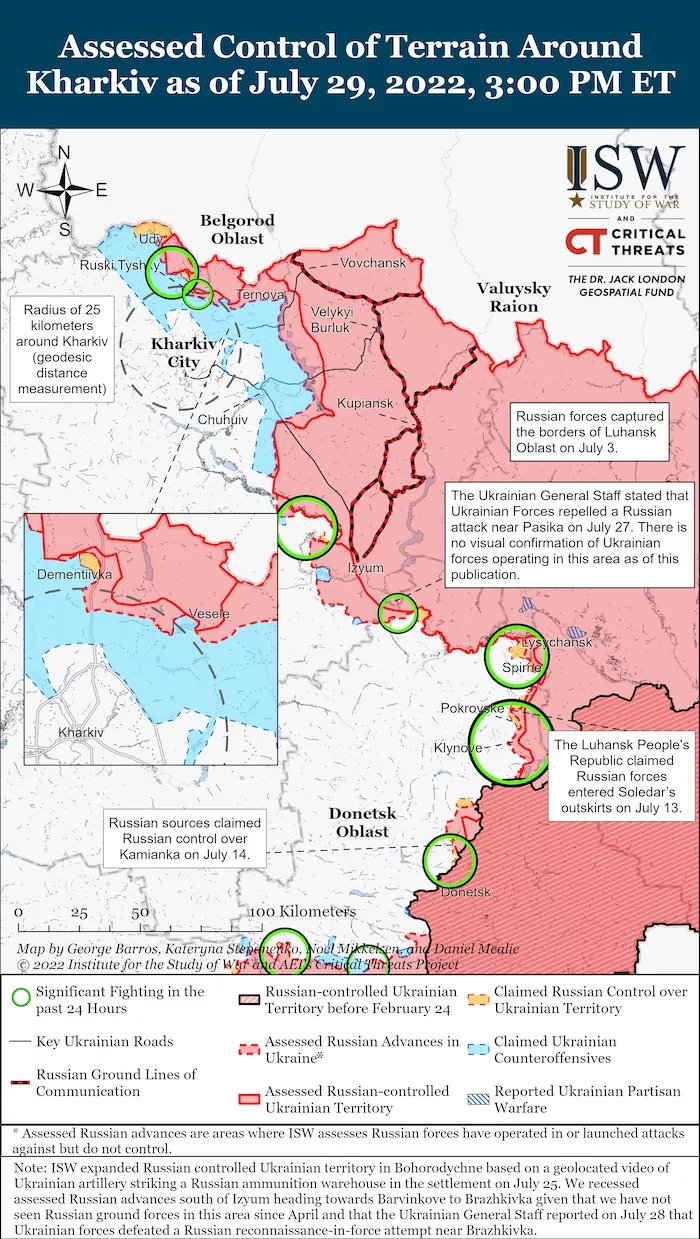
This strategic calculus makes no sense. Does Sullivan really believe that Putin will launch World War III if the United States supplies rockets with a range of about 180 miles but will hold off as long as we’re supplying only rockets with a range of about 50 miles? Or that the provision of HIMARS, NASAMS air-defense systems, 155mm howitzers, Phoenix Ghost drones, Javelins and Stingers isn’t too provocative — but fighter aircraft and tanks would be?
President Biden is right not to send US forces into direct combat with the Russians, but everything else should be fair game, from ATACMS to F-16s to Abrams tanks. The Soviets didn’t hesitate to supply North Korea and North Vietnam with fighter aircraft to shoot down US warplanes. (Soviet pilots even flew for North Korea.) Why shouldn’t we return the favor?
At the beginning of the war in Ukraine, some feared that Putin was acting so irrationally that he might resort to nuclear weapons. But if the past five months have taught us anything, it is that, while the Butcher of Bucha is evil, he is not suicidal or irrational.
Putin pulled back from Kyiv when it was revealed to be a losing cause and made sensible, if brutal, use of Russian artillery in Luhansk. Putin has basically ignored rumored Ukrainian strikes on military targets inside Russia. He hasn’t attacked Poland, which has become the main staging ground for weapons to Ukraine. He hasn’t lashed out since Finland and Sweden set about joining NATO, thereby putting more NATO troops on Russia’s border. […]
He is a classic bully who picks on the weak (Georgia, Ukraine, the Syrian rebels) while shying away from direct confrontations with the strong (the United States, NATO). Putin is rational enough to realize that if his military is having trouble handling Ukraine, it would have no chance in a war with the Atlantic alliance.
The United States matches Russia in nuclear forces and far exceeds it in conventional capabilities. Biden is in a far stronger position than Putin, but he is acting as if he were weaker. Stop letting Putin deter us from doing everything we can to aid Ukraine. Putin should be more afraid of us than we are of him.
The war has already proved costly to Russia: It has lost about 1,000 tanks, and roughly 60,000 soldiers have been killed or wounded. There won’t be much left of the Russian military if the Ukrainians are armed with lots more HIMARS and ATACMS, along with tanks and fighter aircraft. The [next] phase of the war could prove decisive — but only if the United States finally makes a commitment to help Ukraine win.”
Hans Petter Midttun: Today's assessment will be published as a separate article.


